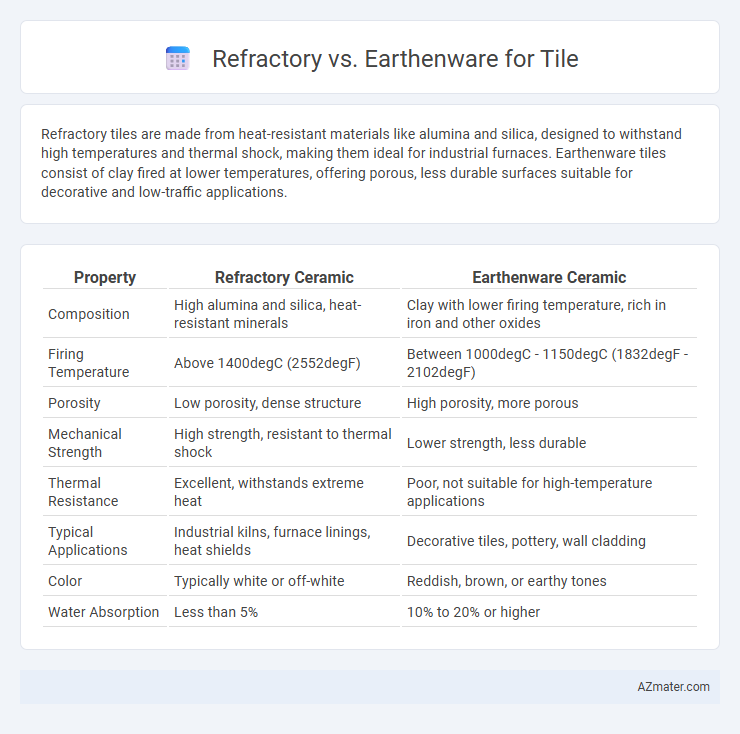Refractory tiles are made from heat-resistant materials like alumina and silica, designed to withstand high temperatures and thermal shock, making them ideal for industrial furnaces. Earthenware tiles consist of clay fired at lower temperatures, offering porous, less durable surfaces suitable for decorative and low-traffic applications.
Table of Comparison
| Property | Refractory Ceramic | Earthenware Ceramic |
|---|---|---|
| Composition | High alumina and silica, heat-resistant minerals | Clay with lower firing temperature, rich in iron and other oxides |
| Firing Temperature | Above 1400degC (2552degF) | Between 1000degC - 1150degC (1832degF - 2102degF) |
| Porosity | Low porosity, dense structure | High porosity, more porous |
| Mechanical Strength | High strength, resistant to thermal shock | Lower strength, less durable |
| Thermal Resistance | Excellent, withstands extreme heat | Poor, not suitable for high-temperature applications |
| Typical Applications | Industrial kilns, furnace linings, heat shields | Decorative tiles, pottery, wall cladding |
| Color | Typically white or off-white | Reddish, brown, or earthy tones |
| Water Absorption | Less than 5% | 10% to 20% or higher |
Introduction to Tile Materials
Refractory tiles are engineered to withstand extremely high temperatures, making them ideal for industrial applications such as kilns and furnaces, while earthenware tiles are composed of porous clay and fired at lower temperatures, suitable for decorative and residential use. The primary distinction lies in their thermal resistance and durability, with refractory tiles offering superior heat tolerance and mechanical strength compared to the more fragile and water-absorbent earthenware. Understanding the material composition and firing process is essential for selecting the appropriate tile type based on performance requirements and environmental conditions.
Defining Refractory Tiles
Refractory tiles are specialized ceramic materials designed to withstand extremely high temperatures, commonly used in industrial furnaces, kilns, and fireplaces. These tiles exhibit high thermal stability, low thermal conductivity, and resistance to chemical corrosion, making them ideal for environments involving prolonged exposure to intense heat. In contrast to earthenware tiles, which are more porous and suited for decorative or low-heat applications, refractory tiles ensure durability and safety in heat-intensive settings.
Understanding Earthenware Tiles
Earthenware tiles, made from natural clay fired at lower temperatures, possess a porous and softer composition compared to refractory tiles. Their distinctive porous nature requires sealing to prevent water absorption, making them better suited for indoor, low-traffic areas. Understanding these characteristics helps in selecting earthenware tiles for decorative or light-use applications rather than high-heat or heavy-duty environments.
Composition Differences
Refractory tiles are composed primarily of high alumina and silica materials designed to withstand extreme heat and thermal shock, making them ideal for industrial furnace linings. Earthenware tiles consist mainly of red clay and silica fired at lower temperatures, resulting in a more porous, less heat-resistant product suitable for decorative and indoor uses. The key composition difference lies in refractory tiles' high refractory oxide content, which provides superior durability and thermal resistance compared to the more organic and porous makeup of earthenware tiles.
Thermal Resistance: Refractory vs Earthenware
Refractory tiles exhibit superior thermal resistance compared to earthenware due to their high alumina and silica content, enabling them to withstand temperatures above 1,500degC without cracking or deforming. Earthenware tiles, made from porous clay fired at lower temperatures (typically 1,000-1,150degC), offer limited heat tolerance and are prone to thermal shock under rapid temperature changes. This makes refractory tiles ideal for industrial furnaces and high-heat applications, while earthenware suits decorative and low-heat environments.
Durability and Lifespan
Refractory tiles are known for their high durability and resistance to extreme heat, making them ideal for industrial applications and environments with intense thermal stress. Earthenware tiles, while more affordable and aesthetically versatile, have a shorter lifespan and lower durability due to their porous nature and susceptibility to cracking under heavy use. Choosing refractory over earthenware significantly increases tile longevity and performance in demanding conditions.
Water Absorption and Porosity
Refractory tiles exhibit low water absorption rates below 5%, attributed to their dense and vitrified structure, making them highly resistant to moisture and thermal shock. Earthenware tiles have higher porosity with water absorption often ranging from 5% to 15%, resulting in increased susceptibility to water damage and less durability in wet environments. The low porosity of refractory tiles ensures better performance in high-temperature and moisture-prone applications compared to the more porous, less water-resistant earthenware.
Common Applications
Refractory tiles are commonly used in high-temperature environments such as furnaces, kilns, and fireplaces due to their excellent heat resistance and durability. Earthenware tiles are typically found in decorative applications and low-heat areas like indoor flooring, wall cladding, and garden paths because of their porous nature and lower thermal tolerance. Choosing between refractory and earthenware depends on the specific heat exposure and mechanical stress requirements of the installation site.
Cost Comparison
Refractory tiles typically cost more than earthenware tiles due to their advanced heat-resistant properties and durability, making them ideal for high-temperature applications such as kilns or industrial furnaces. Earthenware tiles are more affordable, favored for decorative and low-heat environments, but they lack the thermal resilience of refractory options. When prioritizing budget over performance, earthenware offers a cost-effective solution, while refractory tiles justify their higher price through longevity in demanding conditions.
Choosing the Right Tile Material
Refractory tiles offer superior heat resistance and durability, making them ideal for high-temperature environments like fireplaces and industrial settings. Earthenware tiles, while more affordable and easier to install, are less heat resistant and prone to chipping, suitable for decorative or low-traffic areas. Selecting the right tile material depends on the specific application's temperature exposure, durability needs, and budget constraints.

Infographic: Refractory vs Earthenware for Tile
 azmater.com
azmater.com